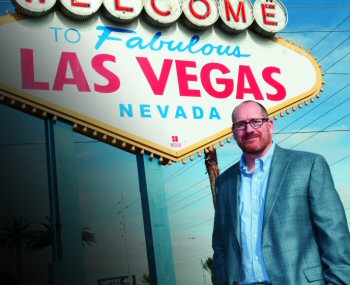By Len Strazewski

|
The Benefits Team.
From left: Destiny Schwurack, Benefits Account Manager; Casandra L. Campbell, Benefits Account Manager; Christopher Campbell, Vice President; Rima Follman, Benefits Project Manager; John Adams, Health & Benefits Manager; Dulcinea Rongavilla, Benefits Account Executive; Annette Purcell, Benefits Account Specialist.
|
After more than 100 years of property/casualty insurance success, what causes an independent agency to build an employee benefits department? The opportunity to grow and serve clients, certainly, but also changing economic conditions.
Founded in 1909, Las Vegas-based Cragin & Pike was built on the growth of the gaming and tourism capital of the United States, serving the property/casualty insurance needs of booming construction and an exploding gaming industry.
"When you fly into Las Vegas," says Chief Executive Officer Greg McKinley, "look out the window and you will see that Las Vegas is an island-there is nothing but desert for 300 miles around us. For good or for ill, the founders of the agency chose to live or die by the future growth of Las Vegas."
And for decades that growth continued, creating opportunities for innovation and revenue, he says. As local employers grew in sophistication and required more complex solutions, the agency evolved, becoming more consultative and oriented to more advanced risk management and loss control techniques.
The arrival of the economic recession in 2007 upset the region's pattern of unimpeded growth, McKinley says. "Las Vegas was the epicenter of the Great Recession. Our region was hit harder than almost any other area of the country."
Construction was halted precipitously and gaming revenues shrank as tourists lost their disposable income. In 2010 the agency decided to add employee benefits to its services, a tactic McKinley and the three other principals at the time developed after consultation with the agency's existing customers and local health plans. "We asked our clients about their employee benefits needs and whether they would be interested in talking to us about consolidating their business if we were to develop benefits services," McKinley says. "They were very supportive."
Local health insurers also supported the decision, pointing to several individual agents and small agencies that might consider joining Cragin & Pike.
The agency interviewed several candidates, finally choosing Chris Campbell, who had corporate benefits management experience and most recently had been operating his own employee benefits agency.
"The employee benefits business in Las Vegas was not focused in any one agency," recalls Campbell, now vice president and principal of Cragin & Pike. Teaming with a successful property/casualty agency opened doors to a broad range of employers seeking sophisticated benefits representation and new ideas for managing their benefits risks, he says.
"We became really good at cross-selling the agency's existing property/casualty customers and introducing new employers to our full range of services," he says. About half of the agency's employee benefits growth was derived from cross-selling existing customers and the remainder from new business.
"There is a great appetite among local businesses to do business with a truly local agency" that has a high level of benefits expertise, he says.

|
| "There is a great appetite among local businesses to do business with a truly local agency."
-Chris Campbell
Vice President
|

|
| Greg McKinley, Rima Follman and Chris Campbell with client Matt Morrison, Director of Health Plans for MGM Resorts, where he oversees the operational effectiveness of the self-insured program that covers more than 23,000 employees in Nevada, Mississippi and Michigan.
|

|
| "We think of our clients' employees as our own and treat them the way we would want to be treated."
-John Adams
Benefits Account Manager
|

|
| "I have had physicians tell me that we have provided them an opportunity to practice medicine the way they have always wanted to practice."
-Greg McKinley
Chief Executive Officer
|
|
Employee benefits now account for about 20% of total revenue and are expected to increase to about 30% of the total within five years, McKinley says. Clients range in size from small businesses with 10 or fewer employees to large gaming and hospitality companies with as many as 20,000 employees, but executives say the agency's strength is serving businesses with about 100 employees that have the critical mass for more sophisticated benefits strategies.
Eight of the agency's 47 employees specialize in employee benefits. Leading health plans in the region include Health Plan of Nevada, a United Healthcare program; Anthem Blue Cross/Blue Shield, Cigna Health, Prominence Health Plan and Humana.
Health Plan of Nevada is the local powerhouse, with premium quotes coming in 20% or more below the competition this year. However, Campbell says that an increasing number of local employers are moving to some level of self-funding, using local third-party administrators to increase their control over claims and take advantage of wellness programs and other cost control strategies.
"Cost control is the number one issue for most business owners," Campbell says. "The cost of health care continues to rise every year, and most business owners are reconciled to annual increases. They realize that they cannot expect to shop their coverage and expect their costs to go down; however, they don't really know the best ways to manage those costs."
Regulatory compliance has also become an important concern as employers cope with the requirements of the Affordable Care Act (ACA) and other federal regulations, he says. "Of course employers need to comply with the new law, but we have discovered that many business owners may have been out of compliance with other regulations. They haven't been filing their 5500s (retirement plan reporting forms) or filing other plan documents with appropriate agencies."
Campbell has introduced Cragin & Pike clients to a wide range of options in benefits plan design and cost management, working with the local health plans for small business and introducing larger employers to self-insurance, which offers more options for cost control and claims reduction.
"Employers are working with us to create a level of employee accountability for their health," he says, initiating wellness and health screening requirements, incentives and disincentives that direct employees to better health decisions and lifestyles.
Campbell says Cragin & Pike, in partnership with MGM Resorts, developed the Direct Care Health Plan-the agency's marquis health plan for the self-insured gaming company. MGM Resorts, is the agency's largest benefits customer, employing more than 53,000 people at its hotels and gaming facilities in southern Nevada.
The Direct Care Health Plan, developed in 2012, directs each enrolled employee to one of 26 primary care physicians who provide a patient-centered medical model. The program is designed to create higher levels of patient satisfaction, Campbell says. Some 23,000 MGM Resorts employees and dependents are enrolled on the Direct Care Health Plan for 2015, he adds.
The network of physicians was recruited by the agency after a stringent evaluation and given wide and immediate authorization to direct patient care. In return, the doctors provide enhanced access for their patients, promising same-day or next-day appointments and guaranteeing that patients will be seen within 30 minutes of their appointment times.
The plan "seems a little HMO-ish," Campbell says, because patients require referrals to see specialists, but the restriction is offset by the faster service and reduced authorization requirements for care directed by the primary care doctors.
The primary care physicians "are the quarterbacks of the health care," Campbell says. "The program has worked phenomenally" in improving both health outcomes and patient satisfaction.
The doctors like it too, McKinley adds. "I have had physicians tell me that we have provided them an opportunity to practice medicine the way they have always wanted to practice."
The agency plans to make a similar network design available to other self-insured employers this year.
Cragin & Pike's account management service is a combination of high technology and high touch, says John Adams, benefits account manager. The agency faces traditional benefits management issues, he explains, including billing errors, claims mistakes and incomplete enrollment. The challenges have been made more complicated by changes in the corporate human resources world and government compliance needs.
When the recession hit in 2007, many employers began to reduce the size of their human resources departments, eliminating the front line of employee problem-solving, he says. "Some employers were left with a single executive in charge of employees. In one case I know, an information technology executive was handed the HR role with little preparation or training in compliance or employee benefits management."
As a result, the agency has had to step into new roles, not only managing the benefits plan design and the enrollment process but handling every step of follow through, building a strategy with employer leadership, and then managing the daily concerns of employees.
"One of our key account management roles is educating and communicating with employees about their benefits and how to use them. Deductibles, copays and the claims process are all important to their successful use of benefits," Adams says.
When employees begin to use their benefits, the agency remains available to advise and facilitate, helping employees understand their health plan and troubleshooting claims that may have been mishandled or miscommunicated.
Employees communicate with the agency directly, Adams says, treating the agency as an extension of the employer's own HR department. "We actually try to keep the employer out of the relationship between the employee and the health plan for privacy reasons."
Last June the agency purchased the Employee Navigator system. The human resources management database system automates some of the account management process, Adams says. The database builds the employee census for submission to a health plan and allows employees to enroll online, adding personal and dependent information as needed.
Adams notes, however, that while technology has been a great resource for the agency, its key differentiation lies in its personal service. "We think of our clients' employees as our own and treat them the way we would want to be treated. We treat their problems as we do our own."
The toughest account management problems, though, may be yet to come. Compliance under the ACA has become employers' most significant benefit management concern, he notes, and those issues continue to evolve.
"There are new issues coming up under the Affordable Care Act every day. We take them as they come."
McKinley agrees and says that more value-added services are in the agency's future as the firm expands its human resources consulting and vendor management to meet the expanding compliance challenges.

|
| The Employee Benefits Team.
|
The author
Len Strazewski is a Chicago-based writer, editor and educator specializing in marketing, management and technology topics. In addition to contributing to Rough Notes, he has written on insurance for Business Insurance, Risk & Insurance, the Chicago Tribune and Human Resource Executive, among other publications.
|





